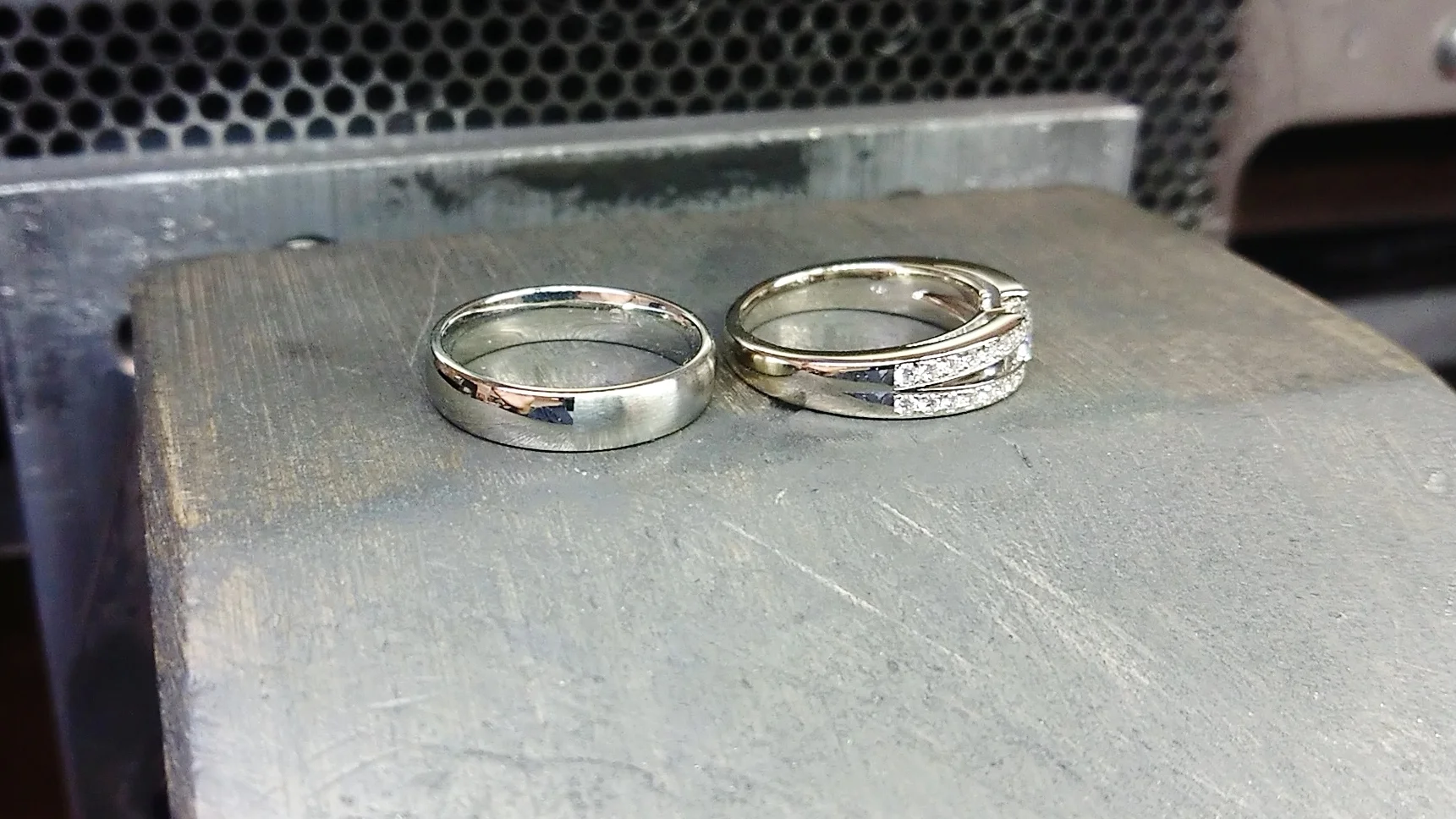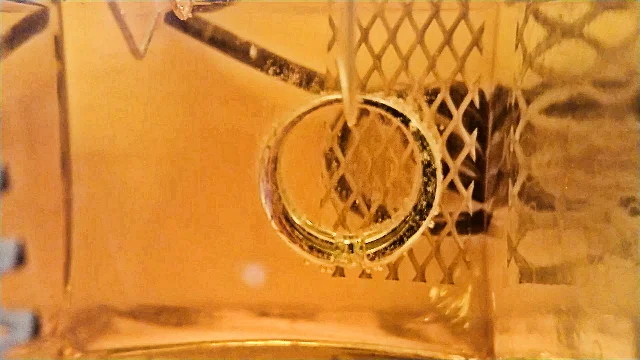
19K Ultra White Gold
REAL WHITE GOLD DOES EXIST
Everything about white gold
“My white gold jewelry remains white. To me, only the best is good enough.”
Everything You Need to Know About 19 kt White Gold
19kt white gold is an innovative option within the jewelry profession as it offers an ultra-white color. This white gold is so white that rhodium plating is not necessary, eliminating concerns about discoloration. Additionally, 19kt white gold is much harder than all types of 14kt and 18kt white gold. That is why I offer 19kt white gold to my clients, as I always strive to provide the best quality to my customers.
Rhodium plating has a significant drawback. Unlike gold plating or silver plating, the rhodium layer can only be applied very thinly. Consequently, a rhodium-plated ring can develop a yellowish tint (in the case of nickel white gold) or a greyish hue (in the case of palladium white gold) after just a few months. It is important for a goldsmith or jeweler to inform customers about this when selling a piece of white gold jewelry to prevent disappointments and complaints.
In conclusion, when you see white gold jewelry in the display window of a jeweler, you are not seeing the actual color of the white gold but rather a thin layer of rhodium that gives the jewelry its "true" white color. This layer wears off relatively quickly from precious jewelry. Argen's 19kt white gold solves this problem by being naturally white without the need for rhodium plating. Therefore, 19kt white gold is the only authentic white gold that maintains its white color.
In the Netherlands, there are two recognized white gold grades: 14 carats (585) and 18 carats (750). These can be further divided into two groups: nickel white gold alloys and palladium white gold alloys. So, what are the differences and the pros and cons?
Let's start with the price. 14kt nickel white gold is the most affordable option among the four. If price is a deciding factor, this is the best choice. 14kt palladium white gold is slightly more expensive. Both alloys are not naturally white and require rhodium plating. Moving up in price, we have 18kt nickel white gold. The most expensive alloy is 18kt palladium white gold. Palladium alloys are pricier because palladium is a dense precious metal that, when combined with gold, adds weight to the jewelry.
* In the Netherlands, only two gold contents are officially recognized as gold: 18kt (minimum 750 fine gold) and 14kt (minimum 585 fine gold). Gold contents lower than 14kt are not recognized as gold in the Netherlands. Despite the slightly higher fine gold content in 19kt white gold (792 fine gold), it will be certified as 18kt gold as it exceeds the required criteria.
Rhodium bath
Rhodium plating of an 18 kt white gold ring
Palladium white gold as an alternative to nickel
Palladium wedding rings are sometimes marketed as nickel-free, primarily targeting individuals with a nickel allergy. This type of allergy is relatively rare but can cause skin irritation in sensitive individuals. In most cases, for the small group of people who experience irritation when wearing white gold, it is typically due to the accumulation of moisture and dirt on the inside of the ring rather than nickel content. The claim of being nickel-free is often used by German wedding ring manufacturers to promote their expensive palladium white gold, and it has proven to be an effective marketing strategy in Germany. Genuine nickel allergies are uncommon occurrences. Furthermore, some individuals may experience allergic reactions to the copper content in rose gold, although it tends to receive less attention. It's worth noting that stainless steel, whether in the form of cookware or luxury watches, does contain nickel.
Platinum as an alternative to white gold
If the options above are not suitable for you and you still desire a white gold piece of jewelry, you can consider opting for platinum 950 (Pt). Platinum is a naturally white-gray precious metal and does not require rhodium plating. It's important to note that platinum is not gold and should not be compared to white gold. Platinum is known for its durability and toughness, but it is also very soft, heavy, and challenging to work with. Additionally, platinum jewelry tends to develop a grayer color over time and is more susceptible to damage such as scratches, dents, and bending. Furthermore, platinum is more expensive compared to other types of white gold, and the maintenance costs are also higher.
“Only 19kt ultra white gold from Argen is truly white in color. This makes rhodium plating is no longer necessary!”
The misunderstandings about nickel in white gold
Nickel release legislation is applicable in all European Union countries, with a requirement that the release of nickel must be less than 0.50 µg/cm²/week. It is a common misconception that jewelry should be entirely nickel-free. While the presence of nickel is allowed, white gold must comply with stringent regulations regarding nickel emissions. All white gold alloys available on the Dutch market meet these requirements, including 19kt white gold, which releases less than 0.28 µg/cm²/week.
As a result of this strict legislation, gold producers have been compelled to reduce the nickel content in white gold, leading to a more yellowish-white color. In response, palladium was chosen as an expensive alternative, bringing with it both advantages and disadvantages. However, white gold rings that are 25 years or older often appear whiter in color because they were not subject to the same regulations. Now, there is a better alternative: 19kt white gold. With its unique properties, it is the only gold that truly achieves a white color.
It's worth noting that for piercings and earrings, even stricter delivery standards are in place due to their direct contact with the skin. The release of nickel should be less than 0.20 µg/cm²/week.
An overview of the advantages and disadvantages of the white gold alloys
palladium white gold alloys 14 kt and 18 kt
More expensive than nickel white gold.
A higher specific weight, therefore, relatively heavy.
Gray in color.
Soft
Can become gray from scratches when worn.
Scratches and dents faster.
Color differences can occur when enlarging a ring.
Solder is often not available in the same color, resulting in yellowish solder seams.
Need a rhodium layer to color it really white.
Costly to maintain, because after polishing always has to be rhodium plated to make the color white again.
19kt white gold alloy
Less expensive than palladium white gold
Low specific weight, comparable to 14kt palladium white gold.
Very hard and strong.
White in color (rhodium not required).
Less likely to damage than 14kt, 18kt palladium white gold and platinum.
Plate, wire, casting material and solder available for the goldsmith.
There is only one 19 kt white gold alloy, so always the same color and quality.
Low maintenance costs because no rhodium finish is required.
No color difference when enlarging / adjusting.
Scratches are very superficial and easy to remove.
Economical in maintenance.
Nickel white gold alloys 14 kt and 18 kt
Less expensive than palladium white gold.
Lower specific weight than palladium white gold.
Yellowish color.
Harder than palladium white gold.
Color differences can occur when enlarging a ring.
Solder often not available in the same color, resulting in yellowish solder seams.
Rhodium layer needed to color it really white.
More expensive to maintain.
Images of white gold jewelry without rhodium
Image 1 Left Argen 19kt white gold, right 18kt white gold.
Image 2 Left ring 18 kt white gold, middle ring Argen 19 kt white gold, right ring 18 kt palladium white gold.



